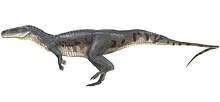Paracrocodylomorpha
| Paracrocodylomorpha Temporal range: Early Triassic - Holocene, 247–0 Ma |
|
|---|---|
 |
|
| Poposauroidea | |
 |
|
| Loricata | |
| Scientific classification | |
| Kingdom: | Animalia |
| Phylum: | Chordata |
| Class: | Reptilia |
| Clade: | Suchia |
| Clade: |
Paracrocodylomorpha Parrish, 1993 |
| Subtaxa | |
Paracrocodylomorpha is a clade of crurotarsan archosaurs that includes crocodylomorphs and several closely related Triassic forms. Erected in 1993, the clade usually contains early crurotarsan taxa like Poposauridae and Gracilisuchus. These groups are considered sister taxa of the clade Bathyotica, which includes Crocodylomorpha and Erpetosuchus. While Erpetosuchus is widely accepted as the closest relative of crocodylomorphs, the relationship of more basal taxa like Gracilisuchus and Ticinosuchus are unclear.
Paracrocodylomorpha is diagnosed by several unique characteristics, or synapomorphies. A ring of bone surrounds a projection on the calcaneum, a bone of the ankle. A ridge on the calcaneum is also present in Paracrocodylomorpha that runs across its entire length on one side. A foramen, or hole, in the base of the skull between the basioccipital and basisphenoid bones acts as an opening for a cavity in the braincase.
Paracrocodylomorpha was named by paleontologist J. Michael Parrish in 1993. Parrish defined Paracrocodylomorpha as the last common ancestor of Poposauridae and Crocodylomorpha and all of its descendants. This clade was nested within Rauisuchia, a group of crurotarsans that once included only extinct Triassic forms but is now generally regarded as paraphyletic. Rauisuchia traditionally included the families Rauisuchidae and Poposauridae to the exclusion of Crocodylomorpha, but Parrish found Poposauridae more closely related to Crocodylomorpha than to Rauisuchidae. This close relationship was recognized since the 1980s. The genus Gracilisuchus was also found to be a close relative of crocodylomorphs and poposaurids but was not placed within Paracrocodylomorpha. Below is a cladogram showing the phylogenetic relationships in Parrish's 1993 study:
...
Wikipedia
